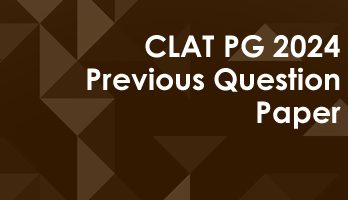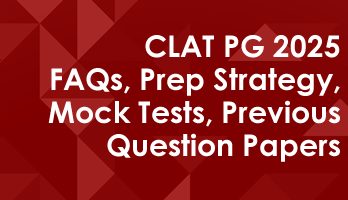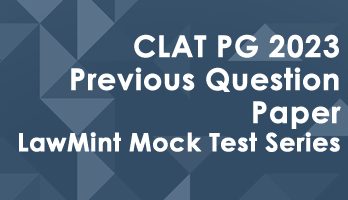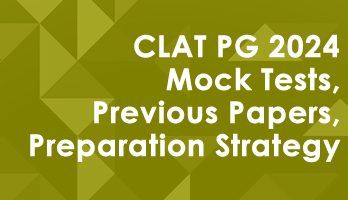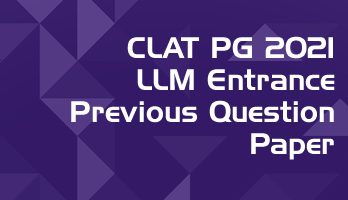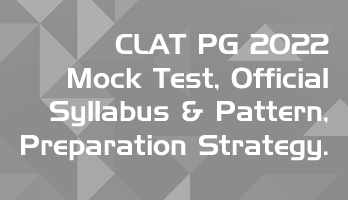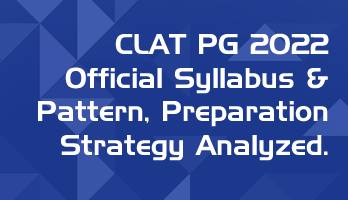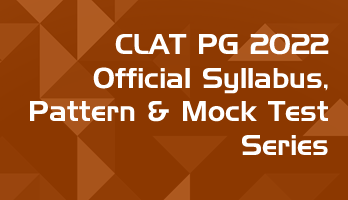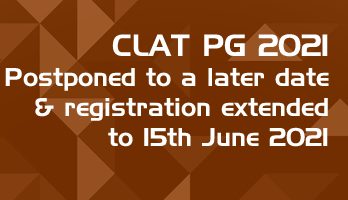This series of articles contains the complete CLAT PG 2020 question paper, conducted for the LLM admissions through the CLAT 2020 exam. In 2020, the pattern of the question paper was changed from the traditional MCQs to a ‘Comprehension based’ model. Each article in this series has one passage and the ten questions following it.
This article contains Passage 9 and the associated questions. The video embedded below discusses the answers as per the official key and the approach that can be used for such questions.
The answers to all the questions, for all the passages in the CLAT PG question paper are discussed in our YouTube video series at : https://www.youtube.com/lawmint
To make use of this question paper :
(1) The links to the complete series of articles is given below
(2) Read the passages and questions that follow
(3) Open our YouTube channel in another window or on your mobile phone (The video covering this specific passage is also embedded below.)
(4) Go through the series of videos where the answers to all the questions are discussed
The original plan by the CLAT Consortium was to have 10 passages, with 10 questions per passage and a subjective part. However, the subjective part was dropped and the number of passages was increased.
The CLAT PG 2020 exam had 12 passages, 120 questions – to be answered in 120 minutes. Click on the links below for the individual passages and the questions associated with the passage.
- Updated as per latest CLAT PG pattern
- Overall there are 300+ comprehension passages - with 2350+ questions
- 100 passages are provided as stand-alone mini mock tests
- 120 passages are combined to form 10 full-length mock tests
- 2020, 2021, 2022, 2023 and 2024 (New Pattern) Question papers included as mock tests
- Answers include the reason or 'rationale' for better understanding
- Order of the questions and answer choices are shuffled in every attempt for better practice
- The passages are of various lengths and complexities for better practice
- Unlimited access & practice - valid for one year from date of purchase
- Accessible 24 x 7 via Smart-Phone browsers and Desktops
- More the 100 LawMint users were selected by various top NLUs in 2020, 2021, 2022 and 2023 - Including NLSIU, NALSAR, NLU-J, WBNUJS
- Our users were also selected for the IIT KGP LLM, NLU Delhi (AILET PG) & DU LLM programs
Also included in the pack : (Useful for non-CLAT LLM entrance exams) :
- 11 CLAT PG old pattern previous Papers - 2009 to 2019 (as mock tests)
- 50 full-length old MCQ format mock tests (100 questions each)
- 50 old pattern MCQ mini-mock tests (25 questions each)
- Summarized overview of Important Jurisprudence topics (For Subjective & Objective questions)
- Overview of all Constitutional Amendments
- All Tests & Previous Papers are timed and have Negative marking for realistic simulation
- Questions & Answer Choices randomly shuffled in every attempt for better practice
Authentic Feedback from previous LawMint users :
I got AIR 21 in CLAT PG. Thank you so much. Your mocks helped me a lot in my preparation 🙂 - Ayushi Jain
I have subscribed to your CLAT PG program and got AIR 36 in this year CLAT PG. I have also secured AIR 54 in AILET PG exam. I would like to thank you. Your mock paper really helps a lot - Shrashank Tripathi
I would like to thank you for the CLAT PG LLM COURSE. Practising mock tests there helped me in getting confidence and hence I was able to get AIR 45 in CLAT PG LLM - Akshay Awasthi
A year back, I relied on the IIT Kharagpur RGSOIPL mock test series by LawMint to prepare for my RGSOIPL entrance test. Few months back, I relied on your UGC NET Law series to prepare for UGC NET. I was the topper of the RGSOIPL entrance, and have cracked JRF in UGC NET. All thanks to LawMint - Anshuman Sahoo
"I got AIR 18 in CLAT PG and General Category rank 28 in AILET PG. I want to thank you for helping me practice well in controlled conditions from any place. It gave me a lot of confidence and I took the tests while travelling too. I also made it to IIT Kharagpur." - Vinodharani
"Lawmint has been of great help to me in securing AIR 25 in AILET PG and AIR 29 in CLAT PG examinations. The subjective and objective approach of the test series kept me up to date with the latest exam pattern." - Bhawna Nanda
"I, Nimmy Saira Zachariah joined you clat test series. I cleared AILET PG with 30th rank. Your test series were of immense help as it gave me clear idea of where my preparations stand thank you once again law mint." - Nimmy S Z
"Hey guys. Where do I start? If I thought that getting AIR 59 in Clat PG was it, then how wrong I was. With Lawmint now I have cracked UGC NET as well." - Joyanta Chakraborty
- CLAT PG 2020 – Comprehension Passage 1
- CLAT PG 2020 – Comprehension Passage 2
- CLAT PG 2020 – Comprehension Passage 3
- CLAT PG 2020 – Comprehension Passage 4
- CLAT PG 2020 – Comprehension Passage 5
- CLAT PG 2020 – Comprehension Passage 6
- CLAT PG 2020 – Comprehension Passage 7
- CLAT PG 2020 – Comprehension Passage 8
- CLAT PG 2020 – Comprehension Passage 9
- CLAT PG 2020 – Comprehension Passage 10
- CLAT PG 2020 – Comprehension Passage 11
- CLAT PG 2020 – Comprehension Passage 12
CLAT PG Comprehension Passage 9
The Archimedean point of Habermas’ philosophy of law is not the concept of natural law. His approach to positive law differs from both Han’s and Hobbes’. For him, positive laws are democratically established human artifacts. In the democratic procedure for legislatures to make laws, even if there may be arguments appealing to the concept of natural law, democratically established positive laws are not duplications of natural laws. Instead, they differ from natural laws both in content and form. The legitimacy and validity of positive laws come exclusively from the democratic process in which laws are established and published. By the same token, the rationality of positive laws comes exclusively from a democratic legislature based upon rational communication under the guidance of the communicative rationality. In social management, morality is complementary to positive law. But positive law is not subordinate to [1]. Instead, the two are parallel institutions.
Habermas shares with Han and Hobbes the view that positive laws have two salient features. First, they are written and publically published. Second, they are backed by those who have a monopoly on force. The second feature of positive laws is dubbed by Habermas as the “facticity” of law. The facticity or social reality of positive laws is that they are compulsory and backed by sanctions. As Habermas puts it, “Such laws appear as the will of a lawgiver with the power to punish those who do not comply; to the extent that they are actually enforced and followed, they have an existence somewhat akin to social facts.”. Also, for Habermas, as it is for Han and Hobbes, positive law differs from natural law in the sense that positive law is a social institution, a human artifact, not a natural institution. Positive law comes into existence by a historical and public action—that is, the democratically legislation of it and its being publically published.
81. Habermas is a:
a) German Philosopher
b) French Philosopher
c) Western Social Scientist
d) English Jurist
82. For Hobbes, the key tenet of his philosophy is:
a) Natural law is necessary for a good positive law and they are not identical in content.
b) Natural law is not necessary for a good positive law, though they are identical in content.
c) Natural law is necessary for a good positive law, and they are identical in content but differ in form.
d) Natural law is necessary for a good positive law but they differ in both form and content.
83. Which of the following words has been replaced by ‘[1]’ in the above paragraph?
a) Culture
b) Ethics
c) Morality
d) None of the above.
84. Which one of the following statements, correctly conveys the Fuller’s Inner Morality of Law?
a) Every piece of Law, in order to be valid, must fulfil minimum moral standard comprising of certain procedural requirements like generality, Prospectively promulgation, intelligibility and consistency.
b) The contents of every law in order to be valid must be mere minimum moral standard without anything more.
c) The question of morality of every law is a matter for the inner conscience of the legislators and judges have nothing to do with it.
d) The question of morality of law is not for the courts to determine.
85. In which of the following cases, the Supreme Court of India remarked, “ Whenever the Court is entering into a new territory and is developing a new legal norm, discussion of normative jurisprudence assumes greater significance as the Court is called upon to decide what the legal norm should be. At the same time, normative jurisprudence has been to be preceded by analytical jurisprudence which is necessary for the Court to underline existing nature of law.”?
a) Common Cause v. Union of India (2018)
b) Bhupinder Singh v. State of H. P (2011)
c) Kumar v. State of T. N (2013)
d) Gargi v. State of Haryana (2019)
86. Out of the following jurists, whose theory has earned t he name of “Natural Law with a Variable Content”?
a) St. Thomas Aquinas
b) John Locke
c) Hobbes
d) R. Stammler
87. Which of the following philosophers gave the theory of “Communicative Action”?
a) Habermas
b) John Locke
c) Savigny
d) Lon L. Fuller
88. According to Habermas, the existence and legitimacy of Positive Laws hinges upon which of the following?
a) Morality
b) Publication of Laws
c) Rational Democratic Process
d) Judicial recognition
89. Positive Law is called ‘Positive’ because
a) It is made as a result of divine providence
b) It is made as a result of collective positive action
c) It is made by person in authority
d) It is followed by everybody
90. Positivists were romanticists because:
a) They were running away from the realities of post-industrial Britain.
b) They were not imagining a perfectly ordered society.
c) They were depicting the state of law and order of contemporary Britain.
d) None of the above.
- Updated as per latest CLAT PG pattern
- Overall there are 300+ comprehension passages - with 2350+ questions
- 100 passages are provided as stand-alone mini mock tests
- 120 passages are combined to form 10 full-length mock tests
- 2020, 2021, 2022, 2023 and 2024 (New Pattern) Question papers included as mock tests
- Answers include the reason or 'rationale' for better understanding
- Order of the questions and answer choices are shuffled in every attempt for better practice
- The passages are of various lengths and complexities for better practice
- Unlimited access & practice - valid for one year from date of purchase
- Accessible 24 x 7 via Smart-Phone browsers and Desktops
- More the 100 LawMint users were selected by various top NLUs in 2020, 2021, 2022 and 2023 - Including NLSIU, NALSAR, NLU-J, WBNUJS
- Our users were also selected for the IIT KGP LLM, NLU Delhi (AILET PG) & DU LLM programs
Also included in the pack : (Useful for non-CLAT LLM entrance exams) :
- 11 CLAT PG old pattern previous Papers - 2009 to 2019 (as mock tests)
- 50 full-length old MCQ format mock tests (100 questions each)
- 50 old pattern MCQ mini-mock tests (25 questions each)
- Summarized overview of Important Jurisprudence topics (For Subjective & Objective questions)
- Overview of all Constitutional Amendments
- All Tests & Previous Papers are timed and have Negative marking for realistic simulation
- Questions & Answer Choices randomly shuffled in every attempt for better practice
Authentic Feedback from previous LawMint users :
I got AIR 21 in CLAT PG. Thank you so much. Your mocks helped me a lot in my preparation 🙂 - Ayushi Jain
I have subscribed to your CLAT PG program and got AIR 36 in this year CLAT PG. I have also secured AIR 54 in AILET PG exam. I would like to thank you. Your mock paper really helps a lot - Shrashank Tripathi
I would like to thank you for the CLAT PG LLM COURSE. Practising mock tests there helped me in getting confidence and hence I was able to get AIR 45 in CLAT PG LLM - Akshay Awasthi
A year back, I relied on the IIT Kharagpur RGSOIPL mock test series by LawMint to prepare for my RGSOIPL entrance test. Few months back, I relied on your UGC NET Law series to prepare for UGC NET. I was the topper of the RGSOIPL entrance, and have cracked JRF in UGC NET. All thanks to LawMint - Anshuman Sahoo
"I got AIR 18 in CLAT PG and General Category rank 28 in AILET PG. I want to thank you for helping me practice well in controlled conditions from any place. It gave me a lot of confidence and I took the tests while travelling too. I also made it to IIT Kharagpur." - Vinodharani
"Lawmint has been of great help to me in securing AIR 25 in AILET PG and AIR 29 in CLAT PG examinations. The subjective and objective approach of the test series kept me up to date with the latest exam pattern." - Bhawna Nanda
"I, Nimmy Saira Zachariah joined you clat test series. I cleared AILET PG with 30th rank. Your test series were of immense help as it gave me clear idea of where my preparations stand thank you once again law mint." - Nimmy S Z
"Hey guys. Where do I start? If I thought that getting AIR 59 in Clat PG was it, then how wrong I was. With Lawmint now I have cracked UGC NET as well." - Joyanta Chakraborty


